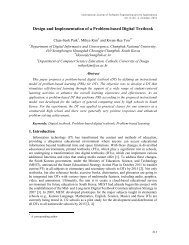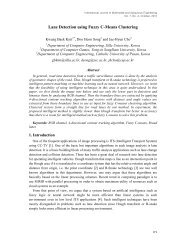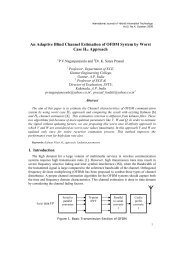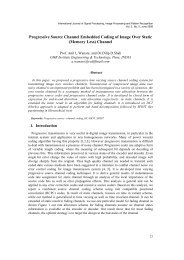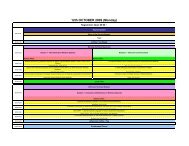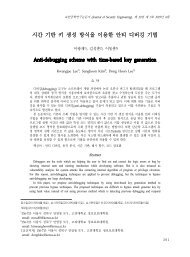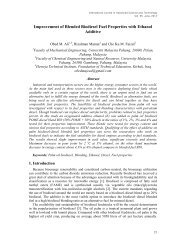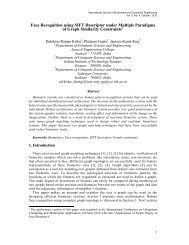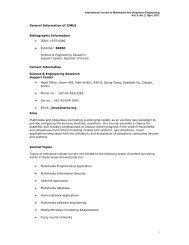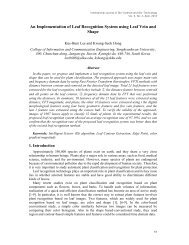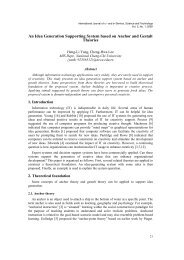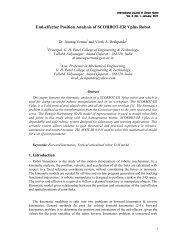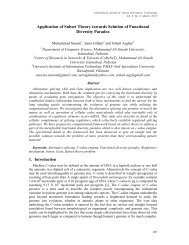Digital Multimedia Database Streaming Framework ... - SERSC
Digital Multimedia Database Streaming Framework ... - SERSC
Digital Multimedia Database Streaming Framework ... - SERSC
Create successful ePaper yourself
Turn your PDF publications into a flip-book with our unique Google optimized e-Paper software.
International Journal of <strong>Database</strong> Theory and Application<br />
Vol. 5, No. 4, December, 2012<br />
<strong>Digital</strong> <strong>Multimedia</strong> <strong>Database</strong> <strong>Streaming</strong> <strong>Framework</strong> Development<br />
Sunguk Lee<br />
Research Institute of Industrial Science and Technology<br />
Pohang, Gyeongbuk, South Korea<br />
sunguk@rist.re.kr<br />
Abstract<br />
The need for providing mobile multimedia services is increasing as the mobility of<br />
individuals’ increases and wireless network are widely adopted. The advantages of Cloud<br />
Computing is utilized to address the shortage in computation, memory, and energy resources<br />
to support advanced graphic processing functions in real-time, especially for high-resolution<br />
digital multimedia contents, as well as security vulnerabilities for wireless networks<br />
connecting mobile terminals. This paper presents a framework for streaming digital<br />
multimedia contents through cloud computing infrastructure. The framework describes the<br />
relationship among the service provider, the cloud provider, and the mobile device. The main<br />
aim of this framework is to provide a scheme for multimedia streaming service that can<br />
operate in a ubiquitous environment through mobile devices.<br />
Keywords: <strong>Digital</strong> Contents, Cloud Computing, streaming<br />
1. Introduction<br />
The rapid delivery of digital multimedia data has been provided by ubiquitous networks.<br />
<strong>Multimedia</strong> contents (e.g. video) floods the web and the amount of its transmission<br />
across the Internet is expected to go off in the near future. The currently used<br />
multimedia processing and transmission schemes and technologies do not adapt to the<br />
need for ubiquitous access to digital multimedia contents from a variety of mobile<br />
terminals. The increased access to multiple services based on real-time multimedia<br />
streaming and the pervasiveness of mobile devices is a make way for an increased<br />
collection of a vast amount of visual data.<br />
Cloud computing as one of the top emerging technologies can offer digital<br />
multimedia contents streaming delivery with an increased robustness and efficiency. It<br />
provides for opportunities that becomes available to mobile users and enables them to<br />
receive more scalable and resilient services, platforms and even infrastructure at lower<br />
cost and with higher business agility.<br />
The need for providing mobile multimedia services is increasing as the mobility of<br />
individuals’ increases and wireless network are widely adopted. Since mobile terminals<br />
do not have enough computation, memory, and energy resources to support advanced<br />
graphic processing functions in real-time, especially for high-resolution digital<br />
multimedia contents, the advantages that Cloud computing will be utilized. Security<br />
67
International Journal of <strong>Database</strong> Theory and Application<br />
Vol. 5, No. 4, December, 2012<br />
vulnerabilities for wireless networks connecting mobile terminals can also be addressed<br />
though provisions in the cloud.<br />
This paper presents a framework for streaming digital multimedia contents through<br />
cloud computing infrastructure. The framework describes the relationship among the<br />
service provider, the cloud provider, and the mobile device. The main aim of this<br />
framework is to provide a scheme for multimedia streaming service that can operate in<br />
a ubiquitous environment through mobile devices.<br />
The rest of this paper is organized as follows: Section 2 explains the overview of cloud<br />
computing and its service offerings; Section 3 outlines the digital multimedia contents<br />
streaming framework design; and the concluding remarks in Section 4.<br />
2. Cloud Computing<br />
Cloud computing refers to the use of computing resources (e.g. hardware and software)<br />
that are delivered as a service over a network (typically the Internet). The name comes from<br />
the use of a cloud-shaped symbol as an abstraction for the complex infrastructure it contains<br />
in system diagrams. Cloud computing entrusts remote services with a user's data, software<br />
and computation [1]. It is defined as an Internet-based computing, whereby shared resources,<br />
software, and information are provided to computers and other devices on demand. It is<br />
already a permanent fixture of consumer oriented services such as email, storage and social<br />
media [4].<br />
Figure 1. Cloud Computing Services<br />
68
International Journal of <strong>Database</strong> Theory and Application<br />
Vol. 5, No. 4, December, 2012<br />
Cloud computing also refers to the development and implementation of models for<br />
enabling omnipresent, convenient, on-demand access to a shared set of configurable<br />
computing resources (e.g. networks, servers, storage, applications, and services) [2].<br />
There are three classifications of Cloud service offerings: the Infrastructure as a<br />
Service (IaaS); the Platform as a Service (PaaS); and the Software as a Service (SaaS).<br />
Software as a Service (SaaS) offers complete and finished applications on demand.<br />
It is a software delivery model in which software and associated data are<br />
centrally hosted on the cloud. SaaS is typically accessed by users using a thin client via<br />
a web browser [5]. SaaS has become a common delivery model for many business<br />
applications, including accounting, collaboration, customer relationship management<br />
(CRM), management information systems (MIS), enterprise resource planning (ERP),<br />
invoicing, human resource management (HRM), content management (CM) and service<br />
desk management. Most widely used examples of SaaS include Gmail, Google Docs,<br />
and Salesforce.com.<br />
Platform as a Service (PaaS) offers an operating system and can provide for every<br />
phase of software development and testing as well as suites of programming languages<br />
that users can use to develop their own applications [6, 7]. It is a category of cloud<br />
computing services that provide a computing platform and a solution stack as a service.<br />
Along with software as a service (SaaS) and infrastructure as a service (IaaS), it is a<br />
service model of cloud computing. In this model, the consumer creates the software<br />
using tools and/or libraries from the provider. The consumer also controls software<br />
deployment and configuration settings. The provider provides the networks, servers,<br />
storage and other services. Commercial examples include Microsoft Windows Azure<br />
and Google App Engine.<br />
Infrastructure as a Service (IaaS) offers end users direct access to processing, storage,<br />
hardware, and servers and other computing resources over the network. The service<br />
provider owns the equipment and is responsible for housing, running and maintaining it.<br />
Examples of IaaS include Amazon Elastic Compute Cloud (EC2), Joyent, Rackspace,<br />
and IBM Computing on Demand.<br />
Cloud computing also considers cloud application deployment and consumption<br />
models in the form public, private and hybrid clouds. Public cloud applications, storage,<br />
and other resources are made available to the general public by a service provider.<br />
Private cloud is cloud infrastructure operated solely for a single organization, whether<br />
managed internally or by a third-party and hosted internally or externally. Hybrid cloud<br />
is a composition of two or more clouds (private, community or public) that remain<br />
unique entities but are bound together, offering the benefits of multiple deployment<br />
models [1].<br />
3. <strong>Framework</strong> Design for <strong>Digital</strong> <strong>Multimedia</strong> Contents <strong>Streaming</strong><br />
<strong>Digital</strong> multimedia streaming refers to the transmission of the digital contents<br />
wherein it is constantly received and presented to the end-users while being delivered<br />
by service or content providers. A user’s media player starts to play the data (e.g. video)<br />
69
International Journal of <strong>Database</strong> Theory and Application<br />
Vol. 5, No. 4, December, 2012<br />
before the entire file has been transmitted. <strong>Streaming</strong> applications must interoperate<br />
seamlessly with other non-broadcast client-server applications such as the Internet<br />
sessions.<br />
The <strong>Framework</strong> presented will provide high-resolution video streams on user’s<br />
mobile terminals, taking into account the necessary context information to ensure<br />
efficiency in terms of delay, functionality richness, and security robustness as shown in<br />
Figure 2.<br />
Figure 2. <strong>Multimedia</strong> <strong>Streaming</strong> <strong>Framework</strong><br />
The service provider will implement Quality of Service (QoS) policies, access<br />
control and authorization models, scalable coding schemes, and as well as accounting.<br />
Service providers will deliver end-users with consulting, legal, real estate, education,<br />
communications, storage, processing, and many other services. <strong>Digital</strong> contents<br />
requested to be streamed are assured with quality, scalable coding mechanisms, and<br />
access and authorization management as it will be delivered to the user’s mobile<br />
terminals.<br />
Scalable coding will provide content delivery and standardize the encoding of highquality<br />
multimedia streams to adapt to different applications where content needs to be<br />
transmitted to many clients with different computational power.<br />
The cloud provider is responsible for resource allocation and management allowing<br />
the optimal use of the shared resources by the different user categories. Queuing and<br />
70
International Journal of <strong>Database</strong> Theory and Application<br />
Vol. 5, No. 4, December, 2012<br />
traffic management is incorporated to support the execution of computing-intensive<br />
functionalities that cannot be run on user’s mobile terminals. The cloud infrastructure<br />
also performs real-time encryption of high-resolution digital multimedia contents.<br />
The client’s mobile terminal is the recipient of the digital multimedia contents<br />
streaming capable of streaming acquisition, and decoding and decrypting management.<br />
The framework for digital multimedia contents streaming will provide delivery of<br />
digital contents and services to client’s mobile terminals that operates in a ubiquitous<br />
environment. The activity flow for the presented framework is described in Figure 3.<br />
Figure 3. <strong>Multimedia</strong> <strong>Streaming</strong> <strong>Framework</strong> Activity Flow<br />
Mobile devices used by clients must support scalable coding functionalities in realtime<br />
multimedia streaming. The decoding scheme will be minimized by the buffering<br />
and queuing management at the cloud provider level decreasing the processing delay.<br />
Techniques for the improvement of compression and encryption schemes will be<br />
deployed to support progressive decoding and decryption in the client’s mobile devices.<br />
4. Conclusions<br />
This paper presents a framework for streaming digital multimedia contents through<br />
cloud computing infrastructure. The framework describes the relationship among the<br />
service provider, the cloud provider, and the mobile device. The main aim of this<br />
framework is to provide a scheme for multimedia streaming service that can operate in<br />
a ubiquitous environment through mobile devices. The framework will provide highresolution<br />
video streams on user’s mobile terminals, taking into account the necessary<br />
context information to ensure efficiency in terms of delay, functionality richness, and<br />
security robustness.<br />
71
International Journal of <strong>Database</strong> Theory and Application<br />
Vol. 5, No. 4, December, 2012<br />
References<br />
[1] http://en.wikipedia.org/wiki/Cloud_computing.<br />
[2] T. K. Mendhe, P. A. Kamble and A. K.Thakre, “Survey on Security, Storage, and Networking of Cloud<br />
Computing”, International Journal on Computer Science and Engineering (IJCSE), vol. 4, no. 11, (2012)<br />
November, ISSN : 0975-3397.<br />
[3] R. V. Ducey, “<strong>Multimedia</strong> Broadcasting and the Internet”, Research and Information Group National<br />
Association of Broadcasters, Washington, DC, (1996), http://www.isoc.org/inet96/proceedings/b3/b3_2.htm.<br />
[4] http://andromida.hubpages.com/hub/cloud-computing-architecture.<br />
[5] http://en.wikipedia.org/wiki/Software_as_a_service.<br />
[6] R. D. Caytiles, S. Lee and B. J. Park, “Cloud Computing: The Next Computing Paradigm”, International<br />
Journal of <strong>Multimedia</strong> and Ubiquitous Engineering, vol. 7, no. 2, <strong>SERSC</strong>, (2012) April, pp. 297-302.<br />
[7] http://en.wikipedia.org/wiki/Platform_as_a_service.<br />
72



